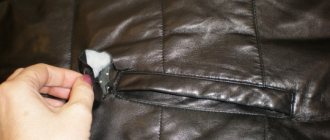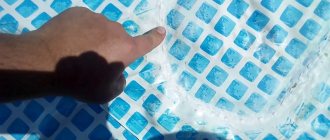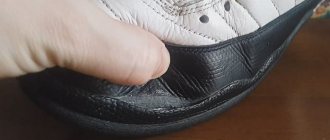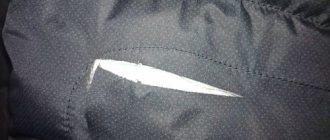The formation of holes in your favorite clothes is always a disappointment, but do not be sad, every item can be restored. How to glue polyester? - to do this, you need to take a small piece of fabric, carefully insert it inside and straighten it, after which you should insert a special strip for gluing there. Such stripes can also be found under the name “cobweb”. The edges of the hole are connected and ironed on top.
Here it is important not to forget that polyester does not like high temperatures, and turn on the “silk” mode. The entire product is ready to wear (except in cases where the strip cannot be inserted).
Types of damage
Even deliberately damaging a tent can be very difficult, but in the forest almost anything can happen. The most common reasons that lead to a tent being sealed are:
- thermal damage - burning the tent with coals from a fire or a cigarette;
- wear and tear – prolonged use, careless operation;
- mechanical damage - ruptures, cuts, punctures.
Each type of damage has its own repair method, because they are very different from each other. However, minor “injuries” can be eliminated without much effort right in nature.
Features of the material of manufacture
When offering fabrics for the top of a down jacket, developers try to ensure that it is functional, protects from wind and cold, and has water-repellent properties. The most commonly used are synthetic, mixed and natural fabrics.
Bologna
Bolognese is a synthetic linen material for the manufacture of outerwear with waterproof properties. The advantages of the material include:
- strength;
- practicality to wear;
- ease;
- maintaining shape;
- high water-repellent properties;
- aesthetic appearance.
Among the disadvantages:
- poor breathability;
- high possibility of rupture if caught on a sharp object;
- ability to melt when exposed to high temperatures or open fire.
Polyester
This is one of the most common synthetic fabrics, used both in pure form and in mixtures with other materials. The advantages of polyester include:
- ease of care;
- machine washable;
- no deformation when worn;
- heat resistance;
- high water-repellent properties.
Polyester can form folds and creases that cannot be smoothed out. The qualities of polyester are significantly improved when mixed with polyamide, spandex or cotton. When repairing down jackets with a polyester coating, experts recommend not applying patches, but gluing thermal decals or using a special glue to restore damage.
Natural fabrics
Fabrics of plant, mineral or animal origin are called natural. These include cotton, linen, silk, leather and wool. Cotton or its combinations with natural or synthetic fibers are often used for jacket coverings.
Natural fabrics have a number of undeniable advantages:
- antiseptic and hypoallergenic properties;
- comfortable wearing conditions;
- hygroscopicity;
- strength;
- good thermoregulation and ventilation.
See also
Types of adhesives for plexiglass and rules for use at home
Disadvantages include the possibility of color loss, wear, creasing, and shrinkage after washing.
How not to carry out repairs
There are two of the most “harmful” repair methods, which technicians do not recommend resorting to even to temporarily eliminate leaks:
- Sew the edges of the awning with a hem. This method will not save a leaking tent. But a large area of the awning will be damaged by needle punctures.
- Seal the damage with smooth “silver” tape. The effect of such a patch will be temporary, only for a few days. But then it is difficult to remove the remnants of the adhesive layer from the surface of the fabric in order to glue the fabric patch. Sometimes the adhesive from the tape reacts with the moisture-resistant coating, literally being absorbed into the fabric. In this case, the only way to repair is to completely replace the damaged fragment with remnants of adhesive tape with new fabric.
Double patch method
Another way of gluing a bologna jacket is the double patch method. It is considered the most durable and reliable. In this case, polyethylene or non-woven fabric is used instead of glue. To do this, a piece of polyethylene is also cut out along with the patch; it should be slightly smaller in size than the patch. Next, the jacket is turned inside out, the edges of the cut are connected to each other, polyethylene is placed on top, and then a patch. Next, they are ironed through natural fabric at an iron temperature of 100-110 degrees.
Raincoat tent repair
To seal a raincoat tent, you need to have the same tools available as in all previous cases, adding only a few cotton swabs to this list. It is worth pre-treating the surface of the tent with water and any degreaser, and then leaving the tent indoors to dry. It is advisable to have a fan heater or radiator nearby.
After a few hours, apply polyurethane glue to the damaged surface. To ensure the layer lays evenly, use cotton swabs. Moreover, the treatment should be carried out on both surfaces to be glued, carefully lubricating the fabric along the edges. During gluing, it is necessary to maintain a technological pause, carefully and accurately pressing the surfaces against each other. It is necessary to make maximum efforts, since the strength of the fabric connection depends on this.
How to sew up a hole in a jacket?
This method is suitable for sealing small holes and slits, as well as if the product is torn along the seam. For these purposes, you will need a thin long needle, thread to match your outerwear and basic sewing skills. Here is the necessary sequence of actions:
- We measure a double thread up to the elbow and thread it into a needle. We tie a knot at one end of the thread.
- If you need to sew up a small hole, then you need to pierce the jacket from the wrong side, and then carefully sew the product.
If you need to sew a thing along the seam, then there are 2 methods, choose the most suitable one for yourself:
- For the first method, you need to rip the product open from the inside in order to quietly sew it up with bologna. Then you will need to sew the hole made from the inside out.
- If you are not ready to tear the lining, you will have to sew the fabric from the outside. To do this, bring the needle through the wrong side and sew the seam in parallel lines. Most often, the places where tears occur are in the armpits, and there the seam is usually not visible, so you can act boldly.
- When sewing along a seam, you need to start doing this 1-2 centimeters before the start of the tear. You should darn directly along the seam itself, that is, along the thread holes, in order to darn the item as unnoticeably as possible. At the end of the action, we hide the knot from the inside.
How to care for a repaired product (glued or sewn)?
Caring for a high-quality repaired product will not be difficult. The main thing is not to wash the sealed down jacket just a couple of hours after the repair - the glue will set securely only after 8–10 hours. It’s better to wait another day or two before washing.
The sewn product can be washed immediately. After washing and drying, it is recommended to iron the repaired down jacket very carefully. This rule is especially true for things sealed with hot-melt adhesive: the area repaired in this way should not come into contact with the iron.
Repairing worn surfaces
After several years of active use of the tent, the material may begin to allow water to pass through without any visible damage. There is only one reason for this - the polymer water-repellent layer has worn out, and now it is not possible to use camping equipment in the rain. In this case, how can you seal the tent awning or should you throw it away and buy a new one?
To eliminate this problem, it will be enough to buy any impregnation for an awning, for example British-made Granger's. Water-repellent material can be restored easily and quickly at home using the following algorithm.
- We remove the awning fabric from the frame and clean it of dirt with water.
- We lay the fabric on the floor so that it is convenient to work with it.
- We impregnate the tent using a sponge or spray.
- Dry the unfolded material thoroughly.
It is worth noting that such treatment should be carried out every 1-2 years, without waiting for the tent to wear out. You should also apply impregnation strictly according to the instructions, using special protective equipment.
Workshop repairs: what you need to know
Any careless repair, especially thermal sizing, can ruin the awning fabric. Therefore, it is better to contact a workshop. Where to go to get professional repairs?
- Companies producing tents, tents and other products for tourism. Sometimes camping equipment manufacturers repair not only their own products, but also tents from other brands.
- Ateliers providing repair services for tents and tourist furniture.
- Private workshops for sewing and repairing tents with professional equipment.
The repairman will inspect the entire surface of the awning and give recommendations on the feasibility and methods of repair. It is possible that during the inspection other damage and weakened areas of the tissue will be discovered.
Together with a specialist, the tent owner can choose a convenient way to troubleshoot the problem. The workshop can offer the following services:
- Choose a patch that matches the structure and color of the main product;
- Boil tears, patches, seams using professional equipment at temperatures up to 800˚C;
- Replace the damaged part with new fabric;
- Insert a window with blind curtains or a mosquito net at the site of the damage;
- Replace loose fasteners, hooks, and reinforcements for guy cords.
Specialists will carry out repairs better and more accurately than can be done at home. Depending on the region, the cost of repairing 1 meter of awning is from 700 – 800 rubles. The final price of such a service is determined by the size and complexity of the damage, and the degree of wear of the fabric.
- November 12, 2018
- Equipment
- Natali Michaelis
The task of any tent is to effectively protect the interior space from cold, wind, sun and precipitation. Even slight damage to the fabric can lead to a decrease in the protective properties of travel equipment. However, any defect can be repaired at home without much difficulty. Read our article about how to properly seal a tent, what materials need to be used for this, and what the operating principle is.
Tent repair with silicone impregnation
Most often, tents with an outer and inner layer of silicone impregnation are damaged in the area of the seams, so we will consider this particular repair method. If your awning is torn in another place, then repairs must be carried out similarly to the two previous cases.
- We lay out the fabric with the seams facing out and treat the surface with water.
- We disinfect the seams and let the awning dry in a warm room.
- Apply silicone glue in a thin layer using a brush.
- Glue the surfaces and leave them to dry for 24 hours.
Before folding the tent, be sure to sprinkle the seams with talcum powder. It is also recommended to carry out the treatment outdoors in warm weather, as silicone glue can be very toxic. If you have a respirator, then you can carry out repair work in a well-ventilated area.
What kind of glue will help?
When choosing glue for repairing a jacket, you must be guided by several principles. The composition should be:
- waterproof;
- elastic;
- colorless;
- resistant to light and temperature changes;
- do not change the structure of the fabric;
- have a thick consistency;
- do not spread;
- Don't freeze instantly so you have time to make changes.
Among the wide variety of adhesive compositions, you can choose an option suitable for a specific fabric and the nature of the tear.
Polyurethane
This type of glue reliably connects surfaces because it is made on a synthetic basis. It is produced in hard and elastic form. The second option is suitable for repairing jackets, down jackets and other fabric products. It has high adhesion and excellent resistance to temperature changes.
Polyurethane glue performs equally well at temperatures from -50 ⁰С to +120 ⁰С.
Rubber
The adhesive composition, which is based on rubber, is highly elastic and can be used to work with leather, fabric, rubber, glass, and wood. Latex rubber adhesive contains casein, which gives it additional elasticity and water resistance. Seams can be glued with styrene rubber-based glue. The composition, which includes natural rubber, is used to glue leather and fabrics together. It has high elasticity.
Polyvinyl acetate
This type of glue is well known to users as PVA. It can be used for fixation “temporarily” and “permanently”. Usually this glue is washed off after washing, since it does not tolerate moisture. But currently they produce polyvinyl acetate glue with high moisture-resistant characteristics. If desired, you can even find two-component adhesive compositions on sale that can withstand direct contact with water. They are best suited for repairing down jackets and down jackets.
- How to sew up a hole so that the seam is not visible or with a hidden seam - step-by-step instructions
Neoprene
Neoprene adhesive makes it easy to make on-site repairs. It dries in less than a minute and forms a strong bond that is flexible and durable. An adhesive composition based on neoprene can easily withstand elevated temperatures and is recommended for gluing elements made of leather, fabric, and rubber. The glue is transparent, waterproof, and can be used to repair jackets and down jackets.
Hot melt adhesive
Safe and non-toxic hot melt adhesive can be used to glue fabrics together. It is applied using a glue gun, which allows the composition to be distributed evenly over the surface. Hot-melt adhesive takes the form of rods that are melted in a gun, or powder for preparing the adhesive composition. The advantage of hot-melt adhesive is its speed of action.
Adhesive aerosol
The difference between aerosol glue and other types is that it can be applied using a spray can. The sprayer allows you to create an even layer of glue and fix materials in places that are difficult to reach for other types of glue. The connection it creates is elastic, the can is sealed, and the consumption is economical. You can apply several layers of adhesive. Complete drying occurs after 20 minutes.
Polyvinyl chloride
This type of glue is produced in the form of an aerosol. It is sprayed in an even layer on one surface, the second is applied on top and pressed with a press for two hours. Complete drying occurs after 6 hours. The adhesion of polyvinyl chloride glue is high and can be used for different fabric textures.
How not to carry out repairs
Now you know well how to seal a tent at home. However, so that you don’t make common mistakes during the work process, let’s look at the two most “harmful” repair methods, which should not be resorted to even if the leak is temporarily eliminated.
Never sew the edges of the awning to the hem. This method will not save the tent from leaking, but most of the tent will be damaged by needle punctures. This sounds quite simple, but many people neglect this rule and, instead of quality repairs, only make things worse.
It is also highly recommended not to cover any damage with “silver” tape. The effect of such a patch will be temporary, since the tape is unlikely to last more than two days, but the remaining adhesive substance will be extremely difficult to remove from the surface. Sometimes such glue comes into contact with a moisture-resistant coating, after which it is completely absorbed into the fabric. In this case, there is only one thing left - complete replacement of fragments of the damaged fabric with new fabric.
Preparing to seal the hole
How to seal a bolognese jacket? If holes have formed in a pocket, sleeve or along a seam and now the hole significantly spoils the appearance of the outerwear, it needs to be repaired urgently. A patch that will repair cuts, pockets, sleeves and seams is perfect for this. But, unfortunately, at present, at home, a person can only tape his jacket so that the hole is completely masked. How to fix a hole in a jacket with glue? This will be done with a special glue that allows you to close the base of cuts or burns in jackets.
How to disguise a cut or holes on outerwear if it is made of leather?
To seal the hole you will need:
- glue;
- acetone;
- cotton wool;
- iron;
- press;
- scraps to make a patch;
- scissors;
- canvas, which must be dry;
- blade.
To sew your jacket, it is important to follow some tips. First, you need to carefully inspect the burned or cut bologna for damage. After this, the holes and seams of the product are assessed (you also need to pay attention to the lining). If the damage is minor, you can start creating a patch.
First, sew up the torn pocket, sleeve or other part of the jacket (lining) so that it cannot ruin the process of gluing the patch. How to sew a pocket? Usually it is sewn up with white threads from the inside, without making strong stitches.
After this you can start gluing the patch:
- To begin with, we choose the right adhesive base, which should properly glue the bologna. In this case, the selected glue, which should close the hole on the base of the jackets, must be rubber (for example, Moment).
- Now, to sew up the jacket with your own hands, you need to make a couple of patches (each is done using bologna fabric or rubber of the same color). In this case, each patch (the second one is made as a reserve) must be the same size as the burnt or cut hole. They are made using a cloth and scissors.
- When several patches have been made, on jackets with a hole we wipe the damaged area with acetone - this is usually done with a cotton swab. It is necessary to wipe any surface: the base of the seam, between the sleeves or the sleeve itself, between the seam, in pockets, and so on. After that, wait a few minutes (thick Bolognese products will take a little longer).
- How to seal a hole? We apply glue to the previously made patch (how to do this correctly is written on the packaging), and then see that its entire base has been covered with the adhesive mass.
- Carefully and carefully carry out the homemade sealing, since bologna is too “fragile” material - make sure that the patch covers the entire hole in the material. After this, to prevent the fabric from tearing, we apply a bag to the patch, and then press it with a press, the weight of which should be at least a kilogram. All linings of the product must be hidden, and then also pressed with a press.
If the work was done unsatisfactorily and the patch turned out to have a large seam, you can glue it to the inside of the jacket (however, in this case the lining often gets in the way, which means it will need to be carefully removed). After installing the patches, sew up the lining, and if the cut area still looks unsatisfactory, try decorating it.
When buying new clothes, a person expects to wear them for at least one season. But during wear, various situations occur, including damage to the item as a result of mechanical impact.
In order not to buy a new product, you need to know what is on the jacket.
How to properly seal polyester clothing?
To begin repairing the product, you should purchase dry glue tape, also called “non-woven fabric”. The cost of the auxiliary material is low and it is not difficult to find. Any sewing store should have it. In addition, you need to have a piece of fabric, slightly larger for the hole and matching the color of the product, as well as gauze and an iron.
After you have stocked up on everything you need, you need to cut a piece of tape and baste it to the prepared piece of fabric. If this is a jacket, then you will need to get close to the hole from the wrong side, ripping out the lining (very carefully). The better you connect the edges of the hole and straighten the fabric, the less noticeable the restored area will be. After this, the product should be ironed through gauze, but do not forget that the device should not be too hot.
As you can see, in order to get rid of a hole on a product, you do not need special knowledge or large expenses. To secure the result, you can attach thermal application, braid or rivets to the treated area. That's it, your favorite item is ready to use again.
Accessories for decorating a jacket
For decoration (and camouflage) you can use the following accessories:
- Store emblems and adhesive-based patches (check with sales staff to see if the material is suitable). Consider the location. For example, such decor would look more appropriate on or near pockets, on a sleeve or on the back at the level of the shoulder blades.
- Decorative ribbons (same recommendations).
- Metal or plastic accessories: buttons, rivets, eyelets, buttons, zippers and so on.
- Iron-on adhesives.
- In specialized stores you can also find specialized repair kits for certain types of outerwear.
Renewing a down jacket at home
Among other things, you can get creative and show your imagination. To cover awkward holes and update a down jacket, you can use a lot of things, for example, buttons, snaps, rivets, embroidery, pebbles, sequins or other decor. They can be attached to pieces of fabric and then sewn onto the jacket. You can create any pattern - either symmetrical, on both sides of the garment, or single.
As you can see, all of the above methods are quite simple and do not require a lot of effort and money. With these simple methods you can give a “second life” to torn outerwear yourself, without turning to specialists for help.











